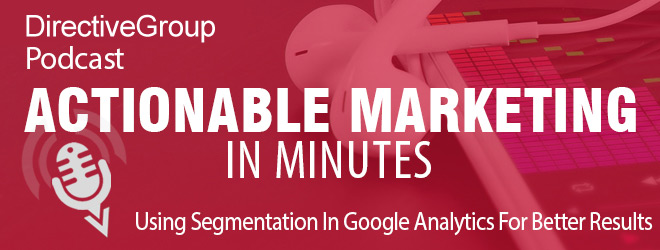In this episode of Actionable Marketing In Minutes we discuss segmentation in Google Analytics and how you can use segmentation to drive better results.
Use the player below to listen to this episode, or the download link to load it on your device for listening later. You can also find our RSS feed by clicking here, or subscribe by email in the sidebar to the left.
Download our Marketing To Millennials eBook here!
Not able to listen? Why not read the episode transcript below:
Problem:
You’ve heard us discuss segments from time-to-time in the course of talking about various marketing activities. But, it has been a little while since we specifically looked at segments. It’s important information because it is said that segmentation is one of the more useful tools we have available to us to better understand our users and then to effectively satisfy their needs or to provide solutions for their pains.
Before we get started, let’s briefly talk about what a segment is.
A segment is a subset of your analytics data. Segmentation is a way to narrow down your website visitors into more narrowly-defined target groups based on shared characteristics. A segment could be a group of users who live in a certain locale. Or those who are a specific gender. Perhaps those who buy from a certain product line within your offerings. You get the idea.
Look at it this way. You’ve just returned from the farmers’ market with a big bag of fruits and veggies. First, you dump it onto the table and then you organize it into more easily manageable piles of each produce type. You’ll notice you may have a larger heap of potatoes, onions, carrots and maybe a much smaller stack of turnips. Now that your harvest is organized by type, you can start planning recipes around your haul.
The purpose of a segment is through its isolation, it can be thoroughly analyzed and understood. The better understood a particular group is, the easier it is to engage with and respond to them specifically – garnering increased conversion rates.
Solution:
Once you’ve classified a segment, you can decide what specific advertising campaign – or recipe – to use. You can figure out the form of media with which to best impact them or which message will best resonate to reach your desired outcome – which could be an increase in awareness or in sales.
In other words, you will be in a better position to craft a more-focused campaign for each segment. For instance, if you sell cars, you’d consider segments such as young hipsters or maybe new parents. You might consider mature drivers. Each segment will require unique messaging as well as distinctive marketing channels where they will find you.
You can find your segmentation data on your Google Analytics dashboard. Just click on the ‘Reporting’ tab to begin.
Once there, you will find you have the option to choose from up to 1,000 segments per account, but only 100 for any one view. Here are 10 basic segments you can choose from, just to get you started:
* Traffic source: gain helpful insights into the distinctions of their journey.
* Value: identify the source of visitors and track their journey towards your conversion goals.
* Visitor type: determine how your visitors engage with your brand. Are they new, returning, registered or non-registered, as well as other types.
* Demographics: acquire a deeper understanding of how your target group is interacting with your site.
* Location/geography: observe your visitors’ characteristics and see how your performance varies within your target locations.
* Landing page type: understand which landing pages perform optimally. Track those that lead to a conversion. Observe how visitors arriving on a particular landing page are behaving throughout your entire site.
* Technology platform: determine visitor-device characteristics – such as browser type, screen resolution, and mobile apps – which will enable you to make effective design and technology improvements.
* Content viewed: determine which pages, in particular, are more likely to encourage visitors to buy.
* Engagement: helps you take note of and make improvements to pages that produce less engagement.
* Action taken: review which visitors ended up making a purchase and note their pre-sales behavior.
Benefits:
As you can see Google Analytics Segmentation truly is a tool you can use with great success and ease. And, segmentation is not as boring or as daunting as you may have previously thought.
Jump in. Then let us know what segments you used and how your new-found knowledge affected your marketing efforts.
We hope you’ve found this information helpful. Please connect with us on Twitter @DirectiveGroup or on LinkedIn. Let us know what you think and what you’d like to hear about next. And if you like our podcasts please share with your networks using hashtag #actionablemarketing.
Join us next time as we discuss whether or not reviews and gold stars are important on the Internet.
Podcast: Play in new window | Download (Duration: 6:01 — 2.5MB) | Embed
